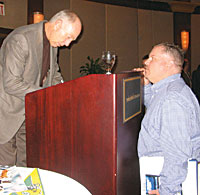
I started liking green in the early 1960s, mostly because the old man watched a lot of football on weekends. The Fighting Irish of Notre Dame had a sprightly dressed green leprechaun and the Green Bay Packers - well, that one should be obvious. In addition, my grade school and future high school both flogged the green, and it was my passionate goal to someday wear those verdant colors.
My bedroom walls were green, and I used to lie in the grass to find how many different shades of green were hanging around in the backyard. Before the Packers ever played in what has since become known as Super Bowl I, I knew that Jerry Kramer, Fuzzy Thurston, Forrest Gregg, and Bill Curry were part of the best green-clad offensive line in professional football. They had taken Bart Starr, Paul Hornung "The Golden Boy," and Jimmy Taylor to two consecutive World Championships before a hung-over Max McGee came off the bench in the first Super Bowl to light up the scoreboard on Jan. 15, 1967.
Obviously, I like green. A lot of other people have started to appreciate green as much as I do, but for different reasons.
The 2006 International Air-Conditioning, Heating, Refrigerating Exposition (AHR Expo) featured the first-ever Greenovation Award three weeks ago in Chicago, as part of the Innovation Awards ceremony, which was added to recognize achievement in green building.
The U.S. Green Building Council created the Leadership in Energy and Environmental Design (LEED) Green Building Rating System® as a voluntary, consensus-based national standard for developing high-performance, sustainable buildings. The LEED program has been around for a few years, and after a stuttering start, now more than 3,500 facilities have applied for LEED certification.
Not only is green a national infatuation, cities like the one I'm speaking at this week (probably for the last time), are jumping on the bandwagon. The Austin, Texas Green Building Program is nationally known for expertise in green residential and commercial construction. The group held a Green By Design Workshop Feb. 4, 2006, and if you go to its Website you can download a pdf of the Seven Steps to Green Building. Eight HVAC contractors are listed in the member directory.
I went to the online fact sheet, Choosing a Green Building Professional, so I could learn what to expect of a green HVAC contractor, especially as I'm going to meet some of them in the flesh at an Austin Air Conditioning Contractors of America meeting. Here's what I found:
Frankly, I didn't find anything that really explained what a Green HVAC contractor does. A lot of residential and commercial customers think of green building as a process using solar energy, straw bales, and rubber tires. And, they would be right. Still, it's very difficult to determine what constitutes green HVAC building practices. Is the offering of R-410A refrigerant enough to qualify? Maybe a high-efficiency boiler?
Some contractors attest that they aren't against green, they just don't know exactly what it is, and what's more, they don't know how to make any money from the concept.
One question I saw on the Austin Website about searching for green professionals: "Do you think this person is trying to give you the right answers just to get your money, or do they demonstrate real commitment to the health of the planet?" Oh, it's not easy being green.
Before the green HVAC movement picks up any more marketing steam, I'd like to know how it's going to really zig and zag down the field if making a profit is a questionable byproduct.
Mike Murphy, Editor-In-Chief, 248-244-6446, 248-244-2905 (fax), mikemurphy@achrnews.com
Publication date: 02/13/2006

Report Abusive Comment